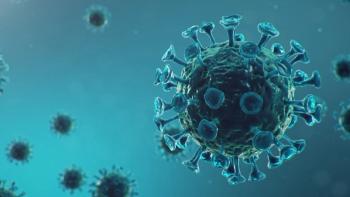The timing of COVID-19 vaccination may contribute to short and temporary changes to individuals’ menstrual cycle, according to new data published in Obstetrics & Gynecology.1
Results of a study out of Oregon Health & Science University (OHSU) found that individuals vaccinated during the first half of their menstrual cycle were more likely to experience temporary changes in their cycle length compared to those vaccinated during the second half. Investigators noted how these findings may be because cytokines, released early in the body’s response to vaccination, can affect the hypothalamic-pituitary-ovarian axis, which regulates cycle timing.
Key Takeaways
- A 1-day increase in cycle length was observed among individuals who were vaccinated in the first half of their menstrual cycle.
- The impact of COVID-19 vaccination on menstrual cycle length may be due in part to interactions between the immune and reproductive systems—for instance, cytokines produced as part of the body's reaction to vaccination can affect the hypothalamic-pituitary-ovarian axis, which controls cycle timing.
- Understanding how COVID-19 vaccines might affect menstrual cycles could ease concerns associated with vaccination and encourage more people to get vaccinated.
“We are constantly learning about how our bodies work together, but we do know the immune and reproductive systems interact closely with one another,” said Alison Edelman, MD, MPH, lead study author and professor of obstetrics and gynecology and division director of Complex Family Planning in the OHSU school of medicine.2 “Based on this relationship, it is certainly plausible that individuals may see temporary changes in their menstrual cycle due to the immune response that vaccines are designed to produce.”
Using menstrual cycle tracking data from Natural Cycles, a digital fertility awareness application, investigators sought to address whether the timing of COVID-19 was associated with changes in the menstrual cycle length. Previous studies had not been able to determine a clear effect.
Data were compared across 3 participant groups: individuals vaccinated in the follicular phase, or the time from cycle day 1 through their ovulation date; individuals vaccinated in the luteal phase, or the day immediately after ovulation through the end of their cycle; and an unvaccinated control group.
Included participants were between ages 18 and 45 years, agreed to release their Natural Cycles data, recorded at least 1 complete menstrual cycle after October 1, 2020, and shared their COVID-19 vaccination status. Further, they completed at least 3 menstrual cycles following pregnancy or following post-positive pregnancy test, demonstrated a normal menstrual cycle length of 24 to 38 days before vaccination, and shared their geographic location.
To accurately assess COVID-19 vaccination’s impact on menstrual cycle length, only individuals vaccinated within the first 38 days of their cycle were included. This criterion helped exclude individuals with potential preexisting cycle irregularities. Individuals experiencing menopause or using hormonal contraception were ineligible for participation.
For each individual, menstrual cycle data was collected from a minimum of 4 consecutive cycles between October 1, 2020, to November 7, 2021. For vaccinated individuals, the 4 cycles included 3 prevaccination cycles and at least the cycle in which the first vaccine dose was received. For unvaccinated individuals, the 4 cycles were collected during a similar time frame.
Initial COVID-19 vaccines were administered between January 2, 2021, and October 31, 2021. For the vaccinated cohorts, cycle 4 was considered the first vaccination cycle, and for the unvaccinated cohort, cycles 4 and 5 were designated as the notional first and second vaccination cycles. The second vaccination cycle for the vaccinated cohorts varied depending on when individuals received their second dose but was most commonly cycle 5.
READ MORE: Study Finds No Link Between COVID-19 Vaccination, Preterm Birth
Among the final study cohort of 19,497 individuals, 9279 received their first vaccine dose in the follicular phase, 5532 received their first dose in the luteal phase, and 4686 individuals did not receive a vaccination. Most vaccinated individuals received an mRNA vaccine (63.8%) and were younger than age 35 years (80.1%), whereas the unvaccinated cohort had a greater proportion of individuals younger than 25 years (19.4% vs about 10% for both vaccinated groups).
Most notably, a 1-day increase in cycle length (98.75% CI, 0.88-1.13) was observed from the 3 prevaccination cycle average to the first vaccination cycle among individuals who were vaccinated in the follicular phase. No changes in cycle length were observed among individuals vaccinated in the luteal phase (–0.09-day change; 98.75% CI –0.26 to 0.07) or among unvaccinated individuals (0.08-day change; 98.75% CI, –0.10 to 0.27).
In the first vaccination cycle, individuals who received a vaccination during the follicular phase experienced the largest clinically significant change in cycle length (8 days or more) at 6.8%, followed by 5% of unvaccinated individuals and 3.3% of individuals vaccinated in the luteal phase (P < .001 for each pairwise comparison). In the second vaccination cycle, the same ranking occurred: 6.8% of individuals vaccinated in the follicular phase had a clinically significant change in cycle length (8 days or more), followed by 5% of unvaccinated individuals, and 4.7% of individuals vaccinated in the luteal phase (P < .001 for each pairwise comparison).
Younger individuals (aged 18-29 years) were more susceptible to clinically significant changes in cycle length for both doses (P < .001 both doses).
Study findings clarifying what to expect regarding the menstrual cycle after COVID-19 vaccination could help address low vaccine uptake, brought forth by concerns about vaccine safety, side effects, and health outcomes. According to the WHO, vaccine hesitancy is one of the top 10 threats to global health.3
“Understanding these changes on a population level allows us to more effectively counsel patients about what to expect with a COVID-19 vaccine,” said Edelman.2 “We hope this work helps validate the public’s experiences and ease fears and anxiety around vaccination.”
READ MORE: COVID-19 Resource Center
References
1. Edelman A, Boniface ER, Male V, et al. Timing of coronavirus disease 2019 (COVID-19) vaccination and effects on menstrual cycle changes. Obstetrics & Gynecology. Published online February 27, 2024. doi:10.1097/AOG.0000000000005550
2. Timing of COVID-19 shot can change menstrual cycle length. News release. EurekAlert. February 29, 2024. Accessed March 1, 2024. https://www.eurekalert.org/news-releases/1036157
3. Kumar S, Shah Z, Garfield S. Causes of vaccine hesitancy in adults for the influenza and COVID-19 vaccines: A systematic literature review. Vaccines (Basel). 2022;10(9):1518. doi:10.3390/vaccines10091518
















































































































